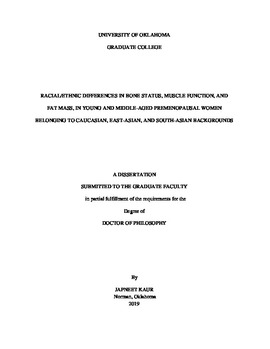| dc.description.abstract | Introduction: Racial/ethnic differences in bone mineral density (BMD) result in increased susceptibility of some ethnic groups to fragility fractures in comparison to others. Although Asians have a lower or equivalent BMD in comparison to Caucasians, they have a significantly lower non-vertebral fracture risk. However, most of these studies are focused on East-Asians, especially Chinese, or do not take Asian sub-groups into consideration. Osteoporosis incidence and fractures rates vary in the Asian sub-groups. Unlike East-Asians, osteoporotic fractures occur 10-20 years earlier in South-Asian women when compared to Caucasian women. Studies determining BMD and its determinants in South-Asians using standardized equipment such as Dual Energy X-Ray Absorptiometry (DXA) are scarce and not well defined. Therefore, in order to reduce the physical and economic burden of osteoporosis, it is important to assess BMD and its determinants considering East- and South-Asians as independent racial/ethnic groups.
Purpose: The purpose of the current study was to determine group differences and relationships between bone mineral density, bone free lean body mass and muscle strength, and fat mass, in premenopausal women aged 18-45 years belonging to three different racial/ethnic groups: Caucasians, South-Asians (SA), and East-Asians (EA). For each ethnicity, the given age range (18-45 years) was divided into two sub-groups: 18-30 years (young), and >30 to 45 years (middle-aged), to allow comparison between women who are accruing bone mass vs. those who have achieved their peak bone mass. Serum concentrations of vitamin D were assessed to further understand the age and ethnicity related differences between these tissues.
Methodology: This was a non-randomized cross-sectional study consisting of 107 participants. Based on their race/ethnicity the participants were categorized into one of the three independent racial/ethnic groups: Caucasian (Cau; n= 46); East-Asian (EA; n= 29); and South-Asian (SA; n= 27). On the basis of age, each ethnicity was further sub-divided into two groups: 18-30 years (young (n= 65; Cau= 24, EA= 24, SA= 17)); and >30-45 years (middle-aged (n=38; Cau= 22, EA= 10, SA= 10)). The first visit included completion of documentation such as the consent form, HIPAA, ethnicity identification form, calcium and vitamin D food intake questionnaires, health status questionnaire, menstrual history questionnaire, physical activity readiness questionnaire (PAR-Q), bone specific physical activity questionnaire (BPAQ), international physical activity questionnaire (IPAQ), and sun exposure questionnaire. This was followed by resting blood pressure measurements and familiarization of the participants with muscle strength tests. The second visit consisted of a blood draw to analyze serum concentrations of vitamin D (25(OH)D) and follicle stimulating hormone, for women >40 years. During the third visit measurements of bone mineral density (areal (a) and volumetric (v) BMD), and body composition (bone mineral content (BMC), bone free lean body mass (BFLBM), whole-body fat mass) were performed using Dual-Energy X-Ray Absorptiometry and peripheral Quantitative Computed Tomography. Following this, upper and lower body muscle strength was measured through the handgrip test, jump test, and 1RM leg press test.
Data Analyses: Analyses were done using SPSS (SPSS Inc., Chicago, IL, version 24.0). Data were presented as mean ± SE. A two-way analysis of covariance was conducted using height, weight, and duration of stay in the United States as covariates, to assess the main effects of age and ethnicity and Ethnicity X Age interactions. This was followed by a Bonferroni post-hoc test to determine group differences between the three ethnic groups. Zero-order Pearson correlation coefficients were used to assess relationships between the dependent variables. Chi-square analyses were conducted between ethnicity, and other categorical variables to determine association and sampling distribution. Finally, multiple linear regression analysis was conducted to examine the association between dependent and independent variables.
Results: Areal BMD at the left femoral neck was higher in Caucasians compared to East-Asian women, and higher in younger Caucasian women compared to young South-Asians. At 38% of the tibia, total vBMD was higher in Caucasians than East- and South-Asian women, and SSI was higher in Caucasians compared to South-Asian women. Endosteal circumference was higher in East-Asian than in Caucasian women, whereas, polar moment of inertia was higher in East-Asians compared to South-Asian women. At 66% of the tibia, total BMC was higher in East-Asian compared to South-Asian women, whereas, cortical BMC was higher in both Caucasian and East-Asian women compared to South-Asians. Total body fat percentage and fat mass were significantly greater in South-Asian women than East-Asians and Caucasians. Moreover, Android/Gynoid ratio was significantly higher in East-Asians compared to Caucasian women. Serum vitamin D levels were higher in Caucasians compared to both East- and South-Asians, whereas sun exposure scores were higher for East-Asians compared to South-Asians. In addition to this, significant positive correlations were noted between age, height, weight, age of menarche, body composition and muscle strength variables, and calcium and vitamin D intakes, and areal and volumetric BMD and bone strength parameters for the three ethnic groups. Moreover, BFLBM, handgrip strength, and physical activity scores were significant predictors of lumbar spine and femoral neck aBMD and bone strength parameters for Caucasians and East-Asians, whereas, fat mass, BFLBM, and physical activity predicted these parameters in South-Asians.
Conclusions: Our results demonstrate that femoral neck aBMD is lower in East-Asians compared to Caucasians. Moreover, in the young groups, South-Asian women have a lower femoral neck aBMD compared to young Caucasians. South-Asians also have a lower vBMD, BMC, and bone strength parameters than East-Asians and Caucasians. This, along with their decreased serum vitamin D levels, sun exposure scores, higher fat mass, and lower leg muscle strength can potentially help to explain the early incidence of osteoporotic fractures in this population. The results of this study can be used for creating awareness among the at-risk ethnicities regarding the importance of adequate physical activity and dietary practices in enhancing bone density. Moreover, the inferences derived from this study can be used to design exercise programs that are ethnicity specific and more effective in preventing osteoporotic fractures.
Keywords: bone; muscle; fat; Asian; Caucasian; vitamin D; Osteoporosis; race; ethnicity; women; physical activity | en_US |

